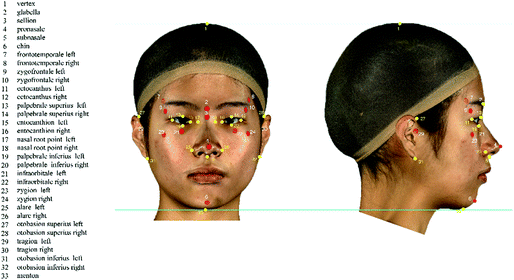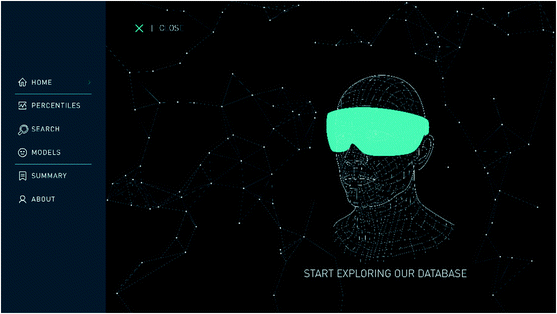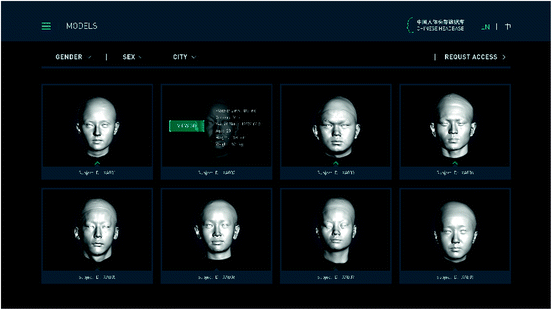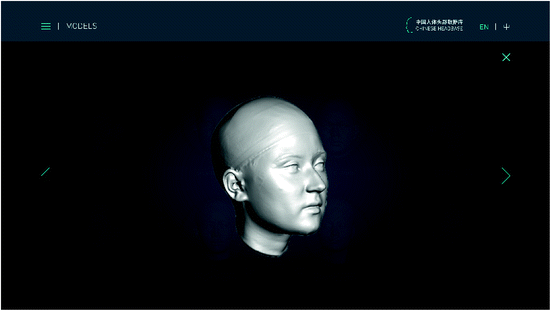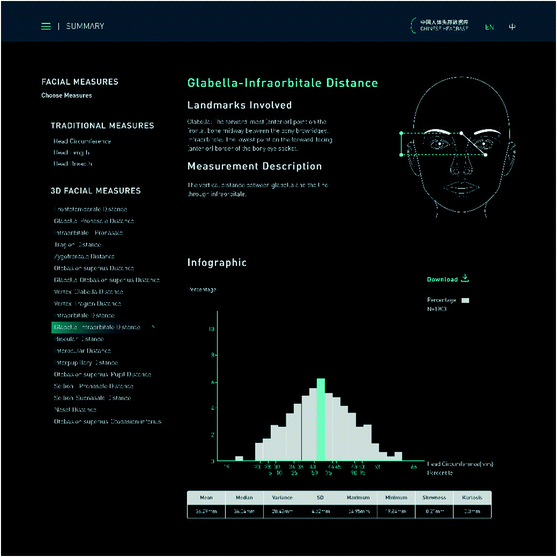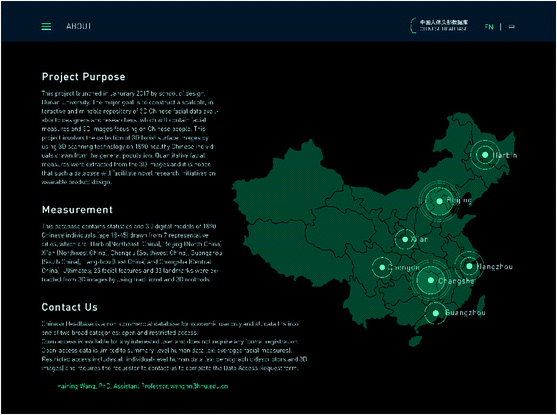Abstract
The complex geometry of the human head’s facial surface presents a challenge for designers and engineers seeking to create properly fitting wearable products. The rapid growth of the Chinese consumer market has created a demand for new Chinese fit wearable products. The head and facial information of the Chinese population differs significantly from that of their western counterparts. The industry requires accurate digital data on Chinese head and facial shapes to develop new consumer products, such as virtual reality (VR) goggles or protective safety glasses. The industry has not had adequate time or expertise to create their own digital databases of Chinese human head surfaces. Therefore, they must rely on head and facial scan databases from 3D scan surveys. Collecting 3D head and facial scan data is the first step in creating a database, and the second step is communicating the results through user-friendly interfaces. A major challenge with 3D scan databases is to make them available online with real-time interactive tools and an effective interface. Industry users require demographic details, searchable database statistics and high-resolution 3D scans that can be delivered to a variety of digital devices. This research has developed an interactive and responsive web-based database of Chinese 3D head and facial models and measurements using a 1900-person head scan survey completed in 2017. It can be used as a reference for the design and testing of head and facial equipment and can facilitate the use and spread of anthropometric databases among designers and researchers.
You have full access to this open access chapter, Download conference paper PDF
Similar content being viewed by others
Keywords
1 Introduction
The rapid growth of the Chinese consumer market has created a significant demand for new Chinese fit wearable products. The industry requires accurate digital data on Chinese head and facial shapes to develop new consumer products such as virtual reality (VR) goggles and protective safety glasses. The head and facial information of the Chinese population varies significantly from that of their western counterparts. For example, Chinese heads are generally characterized as rounder than western heads and as having a flatter back and forehead [1]. Likewise, Chinese civilian adults have a shorter facial length and nose protrusion and larger facial width and lip length compared with the facial dimensions of US subjects [2]. Consequently, it is essential for the industry to have 3D head and facial anthropometric databases to rely on due to the lack of the time or expertise to conduct anthropometric studies.
For decades in China, a few 3D anthropometric surveys on heads and faces have been undertaken. A head-and-face anthropometric study of Chinese civilian workers was conducted by Zhuang et al. [3, 4]. Overall, 3000 subjects were measured using traditional techniques (tapes and calipers), but only 350 of them were selected to acquire their 3D head scans. The data from this survey were limited in terms of demographic coverage. SizeChina [5, 6] captured the 3D digital shapes of the Chinese heads in mainland China. It surveyed 1620 adult civilian subjects aged 18 to over 70 years and provided summary-level data files, digital 3D scans and a set of physical Chinese head forms that were developed from measurements. Nevertheless, the 3D scanning technologies used in SizeChina are not sufficiently developed to collect accurate scan data compared to the latest 3D scanning technologies. Furthermore, the head and facial features extracted a dozen years ago may have a significant difference with the latest data which could affect the product design. More importantly, the database could not be accessed officially since 2014. China National Institute of Standardization collect full-body data (including heads) from 3000 Chinese adults using 3D anthropometric devices in 2009 [7], aiming to revise the survey in 1988 [8]. It provided new data on Chinese adult human body dimensions for more effective and comfortable ergonomic products, machines and work environments. However, these data from the whole-body scan survey cannot be applied in Chinese head and face studies not only because the 3D full body scanner had low accuracy and resolution, but the numbers of facial measurements and statistics values derived from this survey were also relatively insufficient to serve such studies. In summary, these existing Chinese 3D anthropometric surveys are insufficiently qualified to be used as the recourse for the development and enhancement of new Chinese fit wearable products. Therefore, the industry has lacked an up-to-date and accurate Chinese head and facial database for many years. Most of the dimensions for existing wearable products design in China depend on industry experience or modification based on western anthropometric data, which leaves no accurate data to design wearable products such as VR headsets and AR glasses.
Even though 3D anthropometric surveys have been available for years, surprisingly little research and design have been reported concerning the use of 3D data to improve consumer products. Typically, the principal deliverables from previous studies have been 3D scan files, a document with summary-level statistics for the population, including means, standard deviations and percentiles [9], which is an inappropriate way for data use. First, even though these deliverables are well documented, very few of previous surveys provide a process for the industry to interact with them in a meaningful way. For example, they are not available online, and they cannot be effectively interacted with or downloaded. More importantly, these deliverables—the raw individual-level data—are normally not accessible by outside researchers and designers. They are collected to be used by only a small group of investigators [10]. The 3D Facial Norms Database [11] is a large, web-based, interactive craniofacial normative database that allows access to and interaction with the large-scale, individual-level head and facial anthropometric data, including raw 3D facial surfaces. iSize [12] is an international body dimension portal that offers access to body dimensions, size tables and market shares for Germany and France. No Chinese anthropometric survey creates any online database that can be interacted with or downloaded.
In conclusion, the development and enhancement of new Chinese fit wearable products require the creation of an interactive and responsive web-based database containing the latest Chinese 3D head and facial models and measurements, presenting it in a comprehensive way to the industry. The website should contain summary-level statistics, individual-level data and 3D scan models.
2 3D Scan Survey
A full-scale 3D anthropometric measurement was conducted at seven sites in mainland China to collect the anthropometric data of Chinese adults’ heads and faces. We surveyed 1900 male and female adult subjects between the ages of 18 and 45.
During the survey process, participants filled out a questionnaire that recorded basic information including age, gender, family background, and the location where they grew up. Traditional anthropometric measurements were record afterwards, which included height, weight and 3 head measurements (refer to Table 1). A wig cap was fitted to obtain a better scan quality of the hair during the 3D scanning. Fourteen selected manually marked landmarks were directly labeled on the participants’ faces to identify the critical bone structures [13]. Participants were scanned using the Artec Eva® 3D scanner, and high-resolution data was automatically captured as point cloud data.
3 Data Processing
The raw scans collected during the field survey required extensive post-scanning processing before they were suitable for use in the development of a database. All scan files were processed through data alignment, noise elimination, mesh simplification, hole filling and texture mapping, then statistical analysis could proceed subsequently.
Apart from the 14 manually marked landmarks, there were 19 landmarks based on identifiable facial features that were obtained by the trained post-scanning operators. Those 14 manually marked landmarks were the Chin, Glabella, Pronasale, Sellion, Frontotemporale (left and right), Tragion (left and right), Infraorbitale (left and right), Zygion (left and right) and Zygofrontale (left and right) (refer to Fig. 1). The selection of these 33 landmarks (refer to Fig. 1) was based on the head-and-face research in [13]. The coordinates of 33 landmarks were captured because we aimed to obtain more detailed data for analyzing the human face. For facial measurements using completed 3D modeling data, 20 items were measured according to SizeChina [14] and ‘China national standard head-face dimensions of adults’ [15], as shown in Table 1.
The statistical analysis of the anthropometric data was performed using IBM® SPSS® Statistics 24 software. The percentiles (5, 10, 25, 50, 75, 90, and 95), mean, median, variance, SD, maximum, minimum, skewness and kurtosis for every group of measures were calculated.
4 Html5-Based Responsive Database Design
Although previous anthropometry has a long history and has accumulated a vast amount of data, little research or design has been reported concerning using human data to improve design models. It is limited by the publication form of its principal results, such as 3D scan files and documents with summary statistics for the population. Any anthropometric studies that aim to make its information available to designers must address the communication methods that best suit designers’ needs.
An online database website offers many solutions to the communication problem between users and the dataset. First, since the information exists as computer data, it can be readily displayed in the form of a pictorial image, so users can intuitively and easily understand the complex information being described. Second, the web provides varied interactions between users and data instead of only data listed in a spreadsheet. Third, an online dataset could be spread more widely among the public, experts and designers. However, as noted earlier, except for the few databases available on the web, almost all existing anthropometric survey groups saved, delivered and used their results in the form of conventional files, and neither has occurred in China. Therefore, it is essential and ground-breaking for this research to display the overall human head and facial data on the website in a comprehensive and meaningful way.
Crucially, this database’s website is being developed using Html5-based responsive web technology that can adapt to multiple browsers in devices such as mobile phones, PADs and personal computers, which makes the database website respond and adjust to different device environments. A website compatible with various devices satisfies the user’s needs for use in a variety of scenarios, which ensures the continuity of the user experience.
4.1 Database Website Structure
The Chinese head and facial database website (Chinese Headbase) is composed of six modules: (1) home, (2) percentiles, (3) search, (4) models, (5) summary, and (6) about. The structure of this website is shown in Fig. 2.
Home.
There is a human head facial image outlined with lines and grids at the core of the home page, and different kinds of smart glasses’ images alternately emerge over the face. This reveals that the website contains an ample amount of human data for wearable products design. (see Fig. 3 below).
Percentiles.
As a measurement visualization tool for every traditional measurement (head circumference, head length and head breadth) and 3D facial measurements (extracted from 3D models), the line drawing human head facial image changes in real time according to the measurement the user chose, showing the specific location and the shape of the feature selected. Additionally, a percentile visualization tool for all measurements is offered in this module, which is a slider right below the line that draws the human head facial image. The numbers on the left and right sides represent the respective minimum and maximum of measurements. Moreover, the group of subjects for percentiles is customizable. The default percentile is based on the total number of subjects, but users can choose specific target groups by clicking the options in the left area. The percentile would switch in real time based on different groups.
When a user clicks “Frontotemporale Distance” with females, all ages, Guangzhou and Hangzhou checked, the corresponding image appears on the forehead of the head facial image to visually describe the “Frontotemporale Distance”. Its minimum and maximum are 92.179 and 138.559, respectively. Sliding the slider to 25%, the corresponding value is 103.77 mm, and the line drawing feature in the head facial image changes in accordance with the percentile value (refer to Fig. 4). The visualization and customization tools in this database greatly accelerate the understanding of all measurements.
Search.
Users can query and retrieve individual-level raw data in this module. Currently most available databases present only summary-level data, which means that only age- and sex-specific means and standard deviations for all anthropometric measures are available. The lack of raw source materials, such as individual-level data, seriously limits the additional analyses. One of the superiorities of the web-based database is that users are not limited to the summary statistics provided.
Available individual-level raw data include the whole set of 33 3D facial landmarks, including their associated x, y, and z coordinate values, all 3D facial measurements, all traditional measurements, the basic human characteristics (height, weight) and basic demographic information (gender, age, and native city).
In this search page, the search parameters can be defined to query the individual-level data. For example, users can limit queries to only one gender, a specific range of ages, or a specific native city for the subjects. Further, users can limit searches to specific variables of interest, such as landmarks, 3D facial measurements, traditional measurements, and basic human characteristics (refer to Fig. 5). Through this search, the number of participants in the database that are in accordance with the condition(s) of interest would be demonstrated. For example, a user could construct a very narrow search to query how many men between the ages of 18 and 25 have a certain feature in the database. Alternatively, a user can select all measurements in both genders across all ages of all 7 cities. Once the query is determined and submitted, a results page (refer to Fig. 6) will display the items and numbers of the variables selected by users and the number of specific target subjects in that group. The retrieval process can be repeated by revising the criteria each time.
In the search results page, there is also the option to access detailed results from the full individual-level raw data. The full access to the individual-level raw data in the Chinese Headbase is controlled. Users must apply for access through the research team according to the guidelines in the access introduction dialog box. Once access is granted, users can locally work with the full dataset, and the individual-level raw data would be sent by the project team as a standard flat file that can be opened by any spreadsheet program. Individual measurement data and demographic information allow designers to customize the information for their specific needs. For example, a designer might focus on the needs of specific individuals or a demographic group. Designers can approach their own analyses with these raw data.
Models.
This is a module for visualizing and interacting with 3D head facial models. In the past, 3D scan data obtained in anthropometric studies were published as folders, leading to a gap between 3D models and users. However, on this website, users can intuitively browse all the 3D models. They can click on the thumbnails to view the large images online, where the models can be rotated and zoomed in/out on for a better view.
The 3D models’ thumbnail images are tiled on the page in bulk and are accompanied by the subjects’ numbers. All 1900 models’ thumbnails can be seen by accessing the page. Like the searchable individual-level data above, the 3D head facial models can be filtered by choosing different target groups. At first, this page shows all 1900 thumbnail images by default. However, users can customize the genders, ages and native cities of the subjects at the top of the page, and the 3D models’ thumbnail images displayed on the page would be switched in real time with the selected demographic features. For example, a researcher interested in 3D models of men in Xi’an can click on “males” in the “gender” drop-down box and on “Xi’an” in the “city” box. The remaining ages are in their default setting. Then, the thumbnail images are filtered, and 135 eligible 3D models are shown on the page (see Fig. 7 below).
The subject’s basic information will be displayed with subject ID, native place, age, height and weight (refer to Fig. 8) when the mouse cursor hovers over a thumbnail image. After clicking the “view 3D” button, an interface for viewing the single 3D model will pop out where users can rotate and scale the head model by left-clicks, dragging and scrolling mouse action to check more surface details (see Fig. 9 below).
As with the search module, the access is required to locally gain the 3D models. Users can apply for permission from the research team according to the guides in the access introduction dialog box. Once access is granted, 3D models that meet users’ requirements will be sent as standard 3D files that can be opened by any mainstream 3D software. These models have been stripped of identifying colors and textural maps, leaving the surface geometry bare so researchers can directly discover the locations of their interested feature points.
With individual-level raw data and these 3D scan data, researchers can use the landmarks and 3D facial measures to perform analyses, derive additional facial measurements as often as they need.
Summary.
In this module, users can view and download the summary data tables and histograms of all measurements (refer to Fig. 10). Each statistic table lists 8 statistics including the mean, median, variance, standard deviation, maximum, minimum, skewness, and kurtosis for all 1900 participants. Among these data, only the mean and the standard deviation are supplied in the previous methods of data publication [9]. Based on this situation, the median, maximum and other measures were added to directly offer more effective information. The histogram of each feature shows the distribution of this measure data for the 1900 subjects with percentiles marked on the corresponding locations below the x-axis. The bar is highlighted for the user’s easier recognition.
There is a list of 3 traditional measurements and 20 3D facial measurements on the left of this module. Clicking on each option, the table and a histogram of the corresponding feature are shown along with the descriptive image and text. All users have unlimited access to all tables and histograms in this database.
About.
The objective of this module is to introduce the whole 3D anthropometry briefly with a Chinese map set on the right of the page highlighting all 7 mainland cities. We also offer information about the research team including contact information and the address (refer to Fig. 11).
4.2 Responsive Database Website
The Chinese Headbase website is a responsive website that can automatically adapt to whatever device the users are using to view the site, such as mobile phones, PADs and computers, to maximize the user experience. Figure 12 is the screenshot of this website on mobile phone browsers.
5 Conclusion
This research developed a responsive Html5-based database based on a full-scale Chinese head and facial 3D anthropometry dataset built using state of art 3D scanning technology on 1900 healthy Chinese individuals drawn from 7 representative cities. On this website, users can access summary-level statistics for 23 head and facial features extracted traditionally and from 3D scanning data, as well as individual-level data including facial landmark coordinates, anthropometric measurements, 3D head models and demographics for every individual. Users could perform further statistics or ergonomics analyses based on the information acquired from this website. Furthermore, this database offers customizable searches, data visualization and responsive layouts of the database website across different platforms for researchers and designers to interact with complicated anthropometric information easily and smoothly. In summary, this database is the first H5-based website in known studies to provide an effective and intuitive way to demonstrate the up-to-date adult head and facial data drawn from the general Chinese population. This will facilitate the use and spread of the anthropometric dataset among the industry and accelerate novel research on Chinese fit wearable product designs.
However, although current research constructed a scalable, comprehensive and easy-to-use repository of 3D Chinese head and facial data, it’s limited to the sample of Chinese adults between ages of 18 and 45. The lack of adolescent and elder individuals may narrow its usage in the future. Further anthropometric measures of different populations will be implemented, and more design-driven measurements will be added to the database to enrich the data.
References
Ball, R., Shu, C., Xi, P., Rioux, M., Luximon, Y., Molenbroek, J.: A comparison between Chinese and Caucasian head shapes. Appl. Ergon. 41, 832–839 (2010). https://doi.org/10.1016/j.apergo.2010.02.002
Yu, Y., Benson, S., Cheng, W., Hsiao, J., Liu, Y., Zhuang, Z., Chen, W.: Digital 3-D headforms representative of Chinese workers. Ann. Occup. Hyg. 56, 113–122 (2012). https://doi.org/10.1093/annhyg/mer074
Du, L., Zhuang, Z., Guan, H., Xing, J., Tang, X., Wang, L., Wang, Z., Wang, H., Liu, Y., Su, W.: Head-and-face anthropometric survey of Chinese workers. Ann. Occup. Hyg. 52, 773–782 (2008). https://doi.org/10.1093/annhyg/men056
Liu, Y., Xi, P., Joseph, M., Zhuang, Z., Shu, C., Jiang, L., Bergman, M., Chen, W.: Variations in head-and-face shape of Chinese civilian workers. Ann. Occup. Hyg. 59, 932–944 (2015)
Ball, R., Molenbroek, J.F.M.: Measuring Chinese heads and faces (2008)
Ball, R.: 3-D design tools from the SizeChina project. Ergon. Des. Mag. Hum. Factors Appl. 17, 8–13 (2009). https://doi.org/10.1518/106480409X12487281219931
Standards administration of the People Republic of China, GB/T5703-2010: Basic human body measurements for technological design. Standard Press of China, Beijing (2011). (in Chinese)
Standards administration of the People Republic of china, GB10000-88: Human dimensions of Chinese adults. Standard Press of China, Beijing (1989). (in Chinese)
Robinette, K.M., Blackwell, S., Daanen, H., Boehmer, M., Fleming, S.: Civilian American and European surface anthropometry resource (CAESAR), final report, vol. 1. Summary. United States Air Force Research Laboratory (2002). https://doi.org/10.21236/ada406704
Weinberg, S.M., Raffensperger, Z.D., Kesterke, M.J., Heike, C.L., Cunningham, M.L., Hecht, J.T., Kau, C.H., Murray, J.C., Wehby, G.L., Moreno, L.M.: The 3D facial norms database: Part 1. A web-based craniofacial anthropometric and image repository for the clinical and research community. The Cleft Palate-Craniofacial Journal: Official Publication of the American Cleft Palate-Craniofacial Association (2015). https://doi.org/10.1597/15-199
3D Facial Norms Database|Facebase. https://www.facebase.org/facial_norms/
iSize-start. http://portal.i-size.net/
Luximon, Y., Ball, R., Justice, L.: The 3D Chinese head and face modeling. Comput. Aided Des. 44, 40–47 (2012). https://doi.org/10.1016/j.cad.2011.01.011
Ball, R.M.: SizeChina: a 3D anthropometric survey of the Chinese head, p. 54 (2011)
Standards administration of the People Republic of China, GB/T2428-1998: Head-face dimensions of adults. Standard Press of China, Beijing (1998). (in Chinese)
Acknowledgements
This work was supported by the National Key Technology R&D Program of the Ministry of S&T of China 2015BAH22F00.
Author information
Authors and Affiliations
Corresponding author
Editor information
Editors and Affiliations
Rights and permissions
Copyright information
© 2018 Springer International Publishing AG, part of Springer Nature
About this paper
Cite this paper
Wang, H., Yu, Y., Chen, W., Yang, W., Ball, R. (2018). Responsive Web Design for Chinese Head and Facial Database. In: Rau, PL. (eds) Cross-Cultural Design. Methods, Tools, and Users. CCD 2018. Lecture Notes in Computer Science(), vol 10911. Springer, Cham. https://doi.org/10.1007/978-3-319-92141-9_17
Download citation
DOI: https://doi.org/10.1007/978-3-319-92141-9_17
Published:
Publisher Name: Springer, Cham
Print ISBN: 978-3-319-92140-2
Online ISBN: 978-3-319-92141-9
eBook Packages: Computer ScienceComputer Science (R0)

